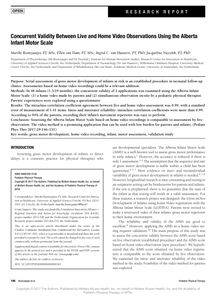Background: Current use of smartphone cameras by parents create opportunities for longitudinal home-video-assessments to monitor infant development. We developed and validated a home-video method for parents, enabling Pediatric Physical Therapists to assess infants’ gross motor development with the Alberta Infant Motor Scale (AIMS). The objective of the present study was to investigate the feasibility of this home-video method from the parents’ perspective. Methods: Parents of 59 typically developing infants (0–19 months) were recruited, 45 parents participated in the study. Information about dropout was collected. A sequential mixed methods design was used to examine feasibility, including questionnaires and semi-structured interviews. While the questionnaires inquired after the practical feasibility of the home-video method, the interviews also allowed parents to comment on their feelings and thoughts using the home-video method. Results: Of 45 participating parents, 34 parents returned both questionnaires and eight parents agreed to an interview. Parent reported effort by the infants was very low: the home-video method is perceived as similar to the normal routine of playing. The parental effort level was acceptable. The main constraint parents reported was time planning. Parents noted it was sometimes difficult to find the right moment to record the infant’s motor behavior, that is, when parents were both at home and their baby was in the appropriate state. Technical problems with the web portal, reported by 28% of the parents were also experienced as a constraint. Positive factors mentioned by parents were: the belief that the home videos are valuable for family use, receiving feedback from a professional, the moments of one-on-one attention and interaction with their babies. Moreover, the process of recording the home videos resulted in an increased parental awareness of, and insight into, the gross motor development of their infant. Conclusion: The AIMS home-video method is feasible for parents of typically developing children. Most constraints are of a practical nature that can be addressed in future applications. Future research is needed to show whether the home-video method is also applicable for parents with an infant at risk of motor development problems.
DOCUMENT

The purpose of this study was a serial assessment of gross motor development of infants at risk is an established procedure in neonatal follow-up clinics. Assessments based on home video recordings could be a relevant addition. In 48 infants (1.5-19 months), the concurrent validity of 2 applications was examined using the Alberta Infant Motor Scale: (1) a home video made by parents and (2) simultaneous observation on-site by a pediatric physical therapist. Parents’ experiences were explored using a questionnaire.
DOCUMENT

OBJECTIVE: Loneliness and social isolation are pressing issues that can seriously impact the mental health and well-being of older adults. Interacting with nature can stimulate a feeling of connectedness. However, for older adults, access to nature is often troublesome because of physical limitations and mobility restrictions.METHODS: In the present mixed-method study, 37 older adults (62-99 years old) with varying care needs and mobility restrictions watched a video presenting a walkthrough of a simulated digital nature landscape.RESULTS: Quantitative results show a significant increase in social connectedness scores and enhanced peacefulness after experiencing a digital nature. Qualitative results stress the importance of variations in nature scenery and highlight the influence of contextual and person-related factors including nature experiences throughout the life span and mobility constraints that older adults may face.CONCLUSION: These findings testify to the potential of using digital nature as a complementary strategy when interactions with outdoor nature become increasingly difficult due to old age.
DOCUMENT
